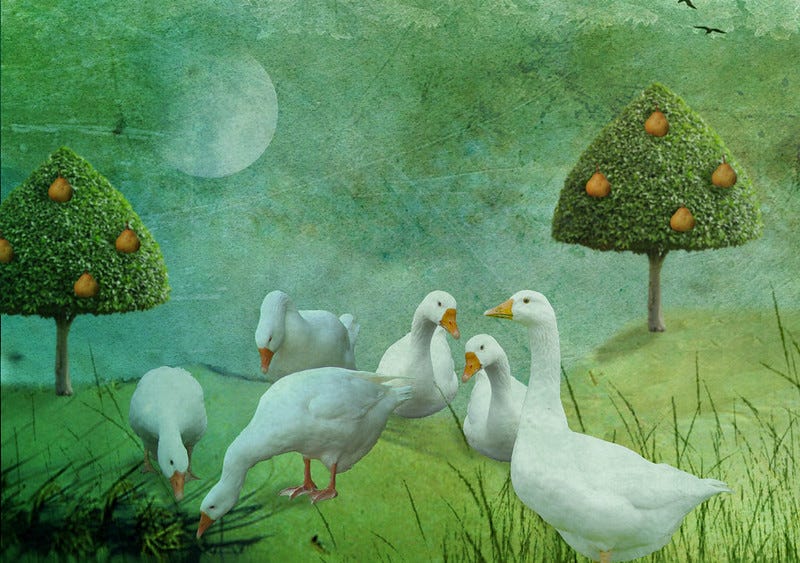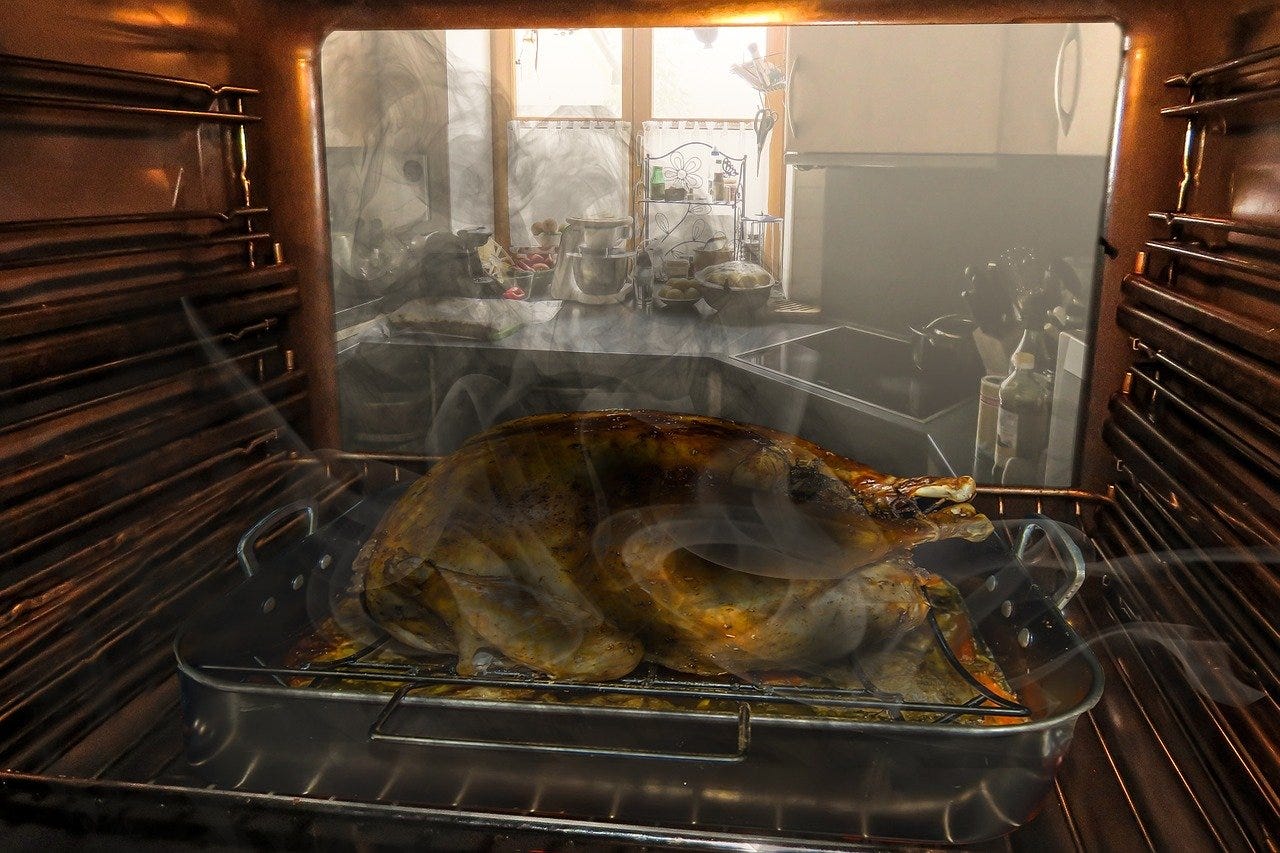What archaeological remains say about our relationship with geese
Old bones are a window into the history of goose consumption.
Welcome to Inkcap, a newsletter about nature, ecology and conservation in the UK, by me, Sophie Yeo.
This is your Wednesday feature. You can still read last Friday’s digest: Tree Planting & Donald Trump's Dunes.
An air of quietness and cosiness has descended upon our household as Christmas advances (or maybe that’s just the Tier 3 restrictions), so I’m bringing you a festive feature this week: an extract from Wintering: A Season With Geese, by Stephen Rutt. There’s a discount code at the bottom of the story, if you want to read the whole book, which I recommend.
As ever, if you can afford it, please consider subscribing, via the button below.
Half past two. Christmas afternoon.
The cats are lurking in torn wrapping paper, having spent the past week fighting over presents that aren’t for them. The goose is carved, after cooking for most of the morning. Its meat is dark and rich – and, yes, delicious.
Maybe it’s the soporific atmosphere of Christmas encouraging me not to think, but I don’t feel like a hypocrite for eating it. It feels like another way of appreciating a species, and while I wish it hadn’t had to die, it feels right to make a celebration of it, to be respectful of its life.
I wouldn’t want it regularly: I have a low meat diet and I want it to stay that way, for my own health as well as the good of the environment, even if this domestic goose had a life in the fields as close to the wild as it could get without migrating.
The taste of goose, in the form of the domesticated bird, is about three thousand years old in China and Egypt. Eating one can be a reminder of old ways of living.
In Michael Shrubb’s masterful yet horrifying book, Feasting, Fowling and Feathers: A History of the Exploitation of Wild Birds, he finds enough evidence to say, “Wildfowl – the swans, geese and ducks – were, and possibly still are, the most important group of wild birds to humanity, providing food, feathers and, latterly, sport.”
There are geese in the archaeological remains of Roman Britain. Domesticated birds – poultry and geese – consumed or sacrificed, then dumped in the midden. This is true also of Saxon Britain.
However, although we can see evidence of the presence of geese back then, it is not until the medieval period that the remains of geese in archaeology become common, revealing the importance of goose to the diet of the period.
In the fifteenth century, at a feast to inaugurate the new archbishop of York, 2,000 geese were eaten, along with 400 swans. A century earlier King Richard II had a feast with 200 geese and a mere 50 swans.
Swans were often skinned, roasted, then the skin replaced around the roasted meat, as a grotesque centrepiece. Geese were not special enough to merit such treatment. That they significantly outnumber swans when they are both on the menu is testament to this.
To supply the birds in large enough numbers for such gargantuan feats of consumption, geese had to be domesticated and farmed.
Hunting for wild geese as we or Peter Scott would understand it did not begin in earnest until guns were accurate enough to hit a small flying target. Before this, wild geese would have been caught in summer, in the period when they are briefly flightless while they moult their wing feathers.
The species that was domesticated – and eaten – in the West was the greylag goose.
Greylag is the alpha goose, the type species. Its scientific name, Anser anser, translates as ‘goose goose’. There are three distinctive populations in Britain: those that breed in Iceland and spend the winter here; those that breed on Scotland’s lochs; and those that never leave the comfort of ponds and lakes, with a ready supply of bad white bread for them to feed on, as familiar to us as introduced species such as the Canada goose.
For something so important to human history – for a bird so big, loud and obvious – greylag geese are a surprisingly dull species. Jeremy Mynott, eccentrically, curates a list of the birds that have this absence of charisma: he includes the greylag alongside the Canada goose, coot, woodpigeon, pheasant and greenfinch as species that “do not have that combination of qualities that give the fizz”.
I don’t agree with the whole list, but the greylag has become a suburban, semi-tame bird, devoid of the wild charm of other species. It does not help that it is a thickset bird, a goose that lacks elegance, with its big body cloaked with a muddy grey-brown plumage, the colour of concrete. Its bill, again big, is an orange that slides into pink at times.
Those that grow up on park lakes often survive on a diet of bread. Bingeing on bad bread when young can affect the growth of the bird’s wings – twisting out from its body instead of lying flush against it. This leaves the geese flightless, something that usually cuts their life short.
It is known, innocently, as angel wing.
The publishers have been kind enough to offer a discount code on Wintering; email info@eandtbooks.com, quoting INKCAP, to get it for £7.99 (that’s two pounds off the retail price and includes p&p). Or you can support writers, bookshops and publishers by getting it for the full price here.
Inkcap is 100% reader-funded.
If you value independent environmental journalism, please consider supporting Inkcap by becoming a paid subscriber. (If it takes you to the landing page, simply re-enter your email.)
Got an opinion? Leave a comment, or get in touch by replying to this email.
Image credits: violscraper, Gerhard G., Adriaen van Nieulandt the younger






When looking at the history of geese you may start around 4500 years ago with the Geese of Medum now in the Cairo Museum. Not only does it tell us of the species found in Egypt at that time but the effects of migration due to 'global cooling' with the effect of the last ice sheet! These species now winter much further north due to 'global warming'!
Sophie it is not entirely true that the re established Greylag population is as sedentary as you suggest birds moult migrate from North Yorkshire to lake Windemere to moult and others go as far as Loch Leven to moult again from at least as far south as North Yorkshire. When I was involved radio tracking and satellite tracking greylags to look at pesticide risk they were in fact exceedingly mobile despite the fact that they can be city park birds one day and miles away the next.